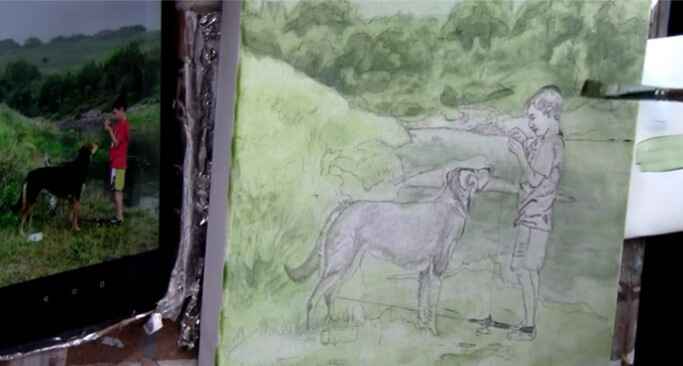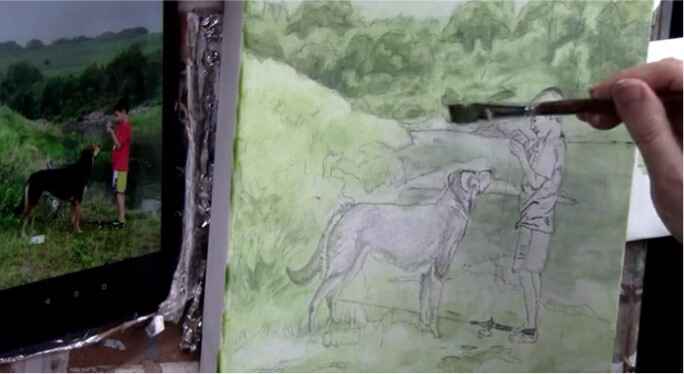- You are here:
- Home »
- Blog »
- Video Tutorial »
- How to Paint Landscapes with Acrylic Glazing in 3 Easy Parts

How to Paint Landscapes with Acrylic Glazing in 3 Easy Parts
Learn how to create luminous, layered landscapes with depth and vibrancy
Introduction

Unlock the secrets to how to paint landscapes with acrylic glazing in 3 easy parts. If you’ve ever admired the vibrant, ethereal quality of painted landscapes and wondered how to achieve similar effects, this guide is for you. Acrylic glazing is a technique that involves layering transparent colors to build depth and luminosity, offering an unparalleled way to bring your landscapes to life.
In this blog post, we’ll demystify the acrylic glazing process by breaking it down into three easy-to-follow parts. Whether you’re an experienced artist or just starting, you’ll find clear, actionable steps to enhance your landscape paintings. We’ll cover everything from preparing your canvas to applying and blending layers, providing you with the tools to create landscapes that are not only visually stunning but also rich in detail and emotion. Dive in and discover how you can elevate your landscape paintings with the transformative power of acrylic glazing.
Part 1: Preparing Your Canvas and Initial Layers
1.1 Choosing the Right Materials
Before diving into acrylic glazing, it’s crucial to gather the right materials. You’ll need:
- A primed canvas or acrylic paper
- High-quality acrylic paints
- Glazing medium
- Brushes (various sizes)
- Palette knife
- Spray bottle for water
The glazing medium is essential as it allows you to create transparent layers of paint without compromising the intensity of the colors.
1.2 Creating the Underpainting
The underpainting is the foundation of your landscape. Start by blocking in the basic shapes and colors using a more opaque application of paint. This stage is about setting the mood and composition of your piece. Don’t worry about details yet; focus on the general placement of elements like the sky, mountains, trees, and water.
Tip: Use cooler tones for distant objects to create a sense of depth and warmer tones for objects in the foreground.
1.3 Letting the Underpainting Dry
Once your underpainting is complete, allow it to dry completely. This is crucial before moving on to the glazing process, as any wet paint can muddy the glazes and ruin the transparency of the layers.
Part 2: Building Depth with Glazes
2.1 Mixing Your Glazes
To mix a glaze, combine a small amount of acrylic paint with a generous amount of glazing medium. The goal is to create a translucent wash of color. You can adjust the ratio depending on the desired transparency.
Tip: Start with lighter glazes and gradually build up to darker tones. This layering technique will give your landscape a sense of depth and dimension.
2.2 Applying the First Glaze
Begin by applying a light glaze over the sky or background elements. Use a soft brush to apply the glaze in thin, even layers. Work quickly and smoothly, as acrylics dry fast. If the glaze appears too intense, you can soften it by misting it with water and blending it with a clean brush.
Technique: Apply glazes in a crisscross pattern to avoid streaks and create a more natural look.
2.3 Building Up the Layers
Continue applying glazes, allowing each layer to dry before adding the next. This process can be repeated multiple times to achieve the desired level of depth and richness in your landscape. For instance, you might apply several glazes of blue and purple to create a deep, atmospheric sky or multiple layers of green and brown to add richness to a forested area.
Tip: Vary the colors in your glazes to create subtle shifts in tone and temperature, enhancing the realism of your landscape.
Part 3: Refining Details and Final Touches
3.1 Adding Highlights and Shadows
Once the glazing layers are complete, it’s time to refine the details. Use more opaque paint to add highlights to areas that catch the most light, such as the tops of mountains or the edges of trees. For shadows, apply darker glazes or use more saturated paint to enhance the contrast.
Technique: Use a dry brush technique to softly blend the edges of your highlights and shadows, creating a more cohesive and realistic effect.
3.2 Enhancing Texture
To add texture to your landscape, consider using a palette knife to apply thicker layers of paint in certain areas, such as rocky surfaces or tree bark. You can also create texture by spattering paint with an old toothbrush or flicking it with your fingers.
Tip: Keep the texture subtle, so it doesn’t overpower the soft, glazed layers underneath.
3.3 Final Adjustments
Take a step back and assess your painting. Look for areas that need more depth or highlights, and make any final adjustments. You can add a final glaze to unify the colors and create a cohesive look. Ensure that the painting is balanced in terms of composition, color, and contrast.
Technique: Use a soft brush to gently blend any harsh edges or transitions between colors.
Acrylic glazing is an excellent technique for creating stunning, realistic landscapes. By breaking down the process into three easy parts—preparing your canvas and initial layers, building depth with glazes, and refining details—you can achieve professional results that capture the beauty of nature. Practice these techniques, experiment with different colors and glazes, and watch your landscapes come to life with depth and vibrancy.
Ready to take your landscape painting skills to the next level? Try out these glazing techniques in your next project, and share your results with us in the comments below! Read more about my additional resources, tutorials, to learn more and check my free courses guide here.
LEARN MORE
- Sketching Your Painting Accurately
- Beginning a Pet Portrait in Acrylic
- The Mystery of Realism in Painting
- Apply A Burnt Sienna Glaze to a Portrait
- Learn How to Sketch a Portrait Freehand in 45 Minutes
- Adding highlights to your acrylic painting
- 5 Excellent Reasons to Use Aluminum Foil
- Paint Realistic Wrinkles in Acrylic
- Painting Clothing in an Acrylic Portrait
- Paint a Cloudy Sky Acrylic
- How to add Semi-Opaque Highlights
- How to Enhance the Contrast in Your Acrylic
- How to Add Glaze to Your Acrylic Painting
- Paint Realistic Reflections on Eyeglasses in an Acrylic Portrait
- Build Up Depth on Your Acrylic Portrait Backgrounds
- How Do You Do Layers With the Glazing Technique?
- Learn How to Paint Wrinkles in Acrylic
Read more about how to paint a portrait that you can surely be proud of!
I’d love to hear your thoughts on this video. Please share it with your friends and family. Let me know if you have any further questions. I’ll greatly help you.
If you’d like to learn more, sign up for my free email tips and video class today.
Learn How to Paint Acrylic Portraits With My Free Mini-Video Course!
Thank you so much for taking the time to read this tutorial and watch the video. That means a lot to me. I hope you find it very helpful in your portrait painting.
Yours for Better Portraits,

P.S. Did you find this post helpful or encouraging? If so, send it in ahead! Let others know with the share buttons below. I’d love to hear your comments. Thank you so much! Also, do you have a question on acrylic portrait painting you’d like answered? Let me know, and I’d be happy to help!
